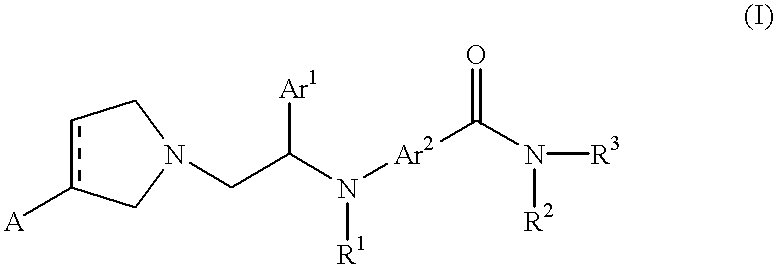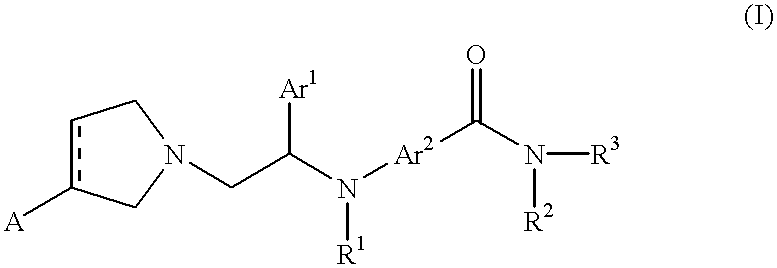Pyrrolidinyl and pyrrolinyl ethylamine compounds as kappa agonists
- Summary
- Abstract
- Description
- Claims
- Application Information
AI Technical Summary
Benefits of technology
Problems solved by technology
Method used
Image
Examples
preparation 1
2-(3-(S)-Methoxymethoxypyrrolidin-1-yl)-2-(R)-phenylethanol
To a stirred solution of (S)-(-)-1,2,4-butanetriol (10.61 g, 0.1 mol) in pyridine (50 ml) was added p-toluenesulfonyl chloride (38.13 g, 0.2 mol) by portions at 0.degree. C. After 14 h stirring, the reaction mixture was poured into conc. HCl aqueous solution including ice and acidified to pH2. The mixture was extracted with ether (100 ml.times.3). The extract combined was washed with brine, dried (Na.sub.2 SO.sub.4), and concentrated to give 18.58 g of colorless oil. To a stirred solution of this crude ditosylate (18.58 g, 45.7 mmol) and dimethoxymethane (50 ml) in CH.sub.2 Cl.sub.2 (50 ml) was added P.sub.2 O.sub.5 by portions at rt (room temperature) and stirred for 26 h. The CH.sub.2 Cl.sub.2 layer was separated and the P.sub.2 O.sub.5 (50 g) solid was washed with CH.sub.2 Cl.sub.2 (50 ml.times.4). The CH.sub.2 Cl.sub.2 layer combined was washed with saturated NaHCO.sub.3 aqueous solution and brine. After dry (Na.sub.2 SO...
preparation 2
2-(3-(S)-Methoxymethoxypyrrolidin-1-yl)-1-(S)-phenylethanol and 2-(3-(S)-Methoxymethoxypyrrolidin-1-yl)-2-(R)-phenylethanol
A mixture of 3-(S)-methoxymethoxypyrrolidine (4.37 g, 33.3 mmol) and (S)-(-)-styrene oxide (4.00 g, 33.3 mmol) in EtOH (40 ml) was refluxed with stirring for 2 h. After evaporation of the solvent, the residue was purified by column chromatography (slicagel: 120 g, CH.sub.2 Cl.sub.2 :MeOH=40:1-20:1) to give 4.91 g (58.7%) of pale yellow oil as 0.65 to 0.35 mixture of title compounds.
.sup.1 H NMR (270 MHz, CDCl.sub.3) .delta. 7.40-7.27 (5H, m), 4.68-4.63 (2.65H, m), 4.35-4.15 (1H, m), 3.90-3.75 (0.7H, m), 3.49 (0.35H, t, J=5.9 Hz), 3.38 (1.95H,s), 3.32 (1.05H, s), 3.10-2.90 (1.3H, m), 2.80-2.40 (4H, m), 2.20-2.00 (1H, m), 1.95-1.75 (2H, m)
preparation 3
2-(3-(S)-Methoxymethoxypyrrolidin-1-yl)-1-(S)-phenylethanol and 2-(3-(S)-Methoxymethoxypyrrolidin-1-yl)-2-(R)-phenylethanol
A mixture of 3-(S)-methoxymethoxypyrrolidine (6.10 g, 46.5 mmol), (S)-(+)-1-phenyl-1,2-ethanediol-2-tosylate (13.6 g, 46.5 mmol) and K.sub.2 CO.sub.3 (7.06 g, 51.1 mmol) in EtOH (80 ml) was refluxed with stirring for 4.5 h. After evaporation of the solvent, CH.sub.2 Cl.sub.2 was added to the residue and washed with saturated NaHCO.sub.3 aqueous solution, brine, dried (Na.sub.2 SO.sub.4), and concentrated to give 14.94 g of crude products, which was purified by column chromatography (slicagel: 150 g, CH.sub.2 Cl.sub.2 / MeOH=50:1-20:1) to afford 7.75 g (66.4%) of brown oil as 0.65 to 0.35 mixture of title compounds.
.sup.1 H NMR (270 MHz, CDCl.sub.3) .delta. 7.40-7.27 (5H, m), 4.68-4.63 (2.65H, m), 4.35-4.15 (1H, m), 3.90-3.75 (0.7H, m), 3.49 (0.35H, t, J=5.9 Hz), 3.38 (1.95H,s), 3.32 (1.05H, s), 3.10-2.90 (1.3H, m), 2.80-2.40 (4H, m), 2.20-2.00 (1H, m), 1.95-1.75 ...
PUM
| Property | Measurement | Unit |
|---|---|---|
| Fraction | aaaaa | aaaaa |
| Fraction | aaaaa | aaaaa |
| Electrical resistance | aaaaa | aaaaa |
Abstract
Description
Claims
Application Information
 Login to View More
Login to View More - R&D
- Intellectual Property
- Life Sciences
- Materials
- Tech Scout
- Unparalleled Data Quality
- Higher Quality Content
- 60% Fewer Hallucinations
Browse by: Latest US Patents, China's latest patents, Technical Efficacy Thesaurus, Application Domain, Technology Topic, Popular Technical Reports.
© 2025 PatSnap. All rights reserved.Legal|Privacy policy|Modern Slavery Act Transparency Statement|Sitemap|About US| Contact US: help@patsnap.com



